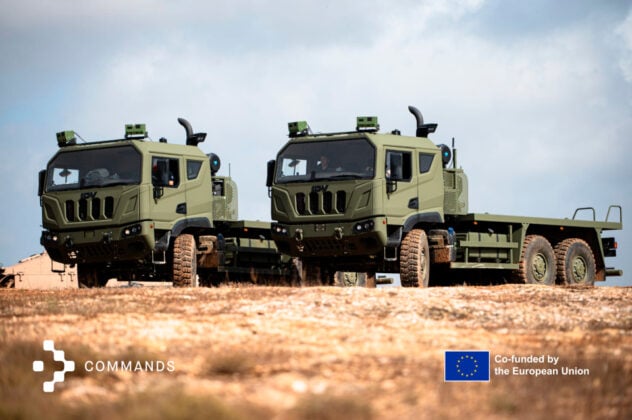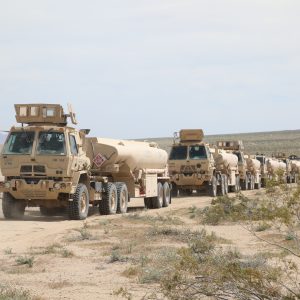Spain has staged the first European demonstration of an autonomous military logistics convoy. Sener Aerospace & Defence closed out its EU‑funded COMMANDS trials in Seville with a live convoy run. In the demo, Sener’s Naviground autonomy linked with Indra’s battle‑management system on GDELS ASCOD and IVECO Defence Vehicles platforms. As a result, the event shows how Europe plans to scale crewed–uncrewed teaming for land logistics in contested zones [1][2][3].
Why this matters for Europe’s ground logistics
Modern land forces depend on uninterrupted resupply. Yet convoys remain some of the most targeted and troop‑intensive missions. By fielding an autonomous military logistics convoy with “follow‑me” and last‑mile shuttle modes, Europe is testing a practical way to keep supplies moving under drone and artillery threat [1][2]. Crucially, the COMMANDS concept treats autonomy as a logistics multiplier, not a lab exercise. It prioritises tight integration with existing vetronics and battle‑management tools [4][5].
Key facts
- Programme & funding: COMMANDS—Convoy Operations with Manned‑unMANneD Systems—was selected under the European Defence Fund (EDF 2021). The EC factsheet cites a total cost of €26.84 million with €24.84 million EU contribution, 36‑month schedule, and a 21‑partner consortium across 10 countries [3][6][7].
- Demonstration host: GDELS Santa Bárbara Sistemas, Seville. Senior attendees reportedly included Spanish Army and DIGAM officials and European defence ministry representatives [1].
- Capabilities shown: “Follow‑me” convoying, autonomous last‑mile shuttle, optionally crewed logistics vehicles automated via Naviground; convoy control integrated with Indra’s BMS on ASCOD IFVs and IVECO logistics trucks [1][2].
- Interoperability: Architecture aligned to NATO digital standards (e.g., GVA/NGVA paradigms and STANAG 4609 for motion imagery) to enable data sharing and coordinated command across crewed and autonomous platforms [1][8].
What COMMANDS changes in practice
Commanders do not just need robots; they need systems that fit the current order of battle. Accordingly, COMMANDS pairs autonomous navigation with existing battle‑management workflows. Indra’s BMS provides the digital backbone, sharing a single operating picture and convoy tasking. Meanwhile, Naviground automates the exposure‑heavy work of driving, spacing and obstacle handling [4][5]. Together, these elements make the autonomous military logistics convoy operationally relevant rather than merely novel.
The design philosophy is “optionally crewed.” Vehicles can be driven manually when doctrine or law requires it. They can switch to autonomous modes where risk or fatigue peaks. For example, in an artillery‑swept corridor, a human‑led spearhead can pull uncrewed followers through waypoints. In the last kilometre, a shuttle can peel off to a forward position without putting a driver in the lethal envelope [1][2].
“A decisive step forward in the autonomy and efficiency of logistical convoys for land operations… strengthening Europe’s sovereign defence technologies.”Sener statement on the Seville demo [1]
“optionally crewed.” Vehicles can be manually driven when doctrine or legal constraints demand it and flipped to autonomous modes where risk or fatigue peaks. In an artillery‑swept corridor, a human‑led spearhead can pull uncrewed followers through waypoints; in the last kilometre, a shuttle can peel off to a forward company position without putting a driver in the lethal envelope [1][2].
“A decisive step forward in the autonomy and efficiency of logistical convoys for land operations… strengthening Europe’s sovereign defence technologies.”Sener statement on the Seville demo [1]
Technical notes: architecture, standards, and safety
Systems integration. The convoy linked IVECO logistics trucks, ASCOD‑family armoured vehicles, Indra’s BMS and Sener’s Naviground. The latter fuses vision, inertial, GNSS and odometry inputs into a navigation solution that works off‑road and under degraded GNSS. In parallel, Indra’s BMS provides blue‑force tracking and mission management. It is also being upgraded for highly digitalised, high‑throughput coordination tasks [2][9].
Interoperability. The project targets compliance with NATO and European digital vehicle and data standards. Reports around the demo highlight alignment with GVA/NGVA‑style architectures and STANAG 4609 motion‑imagery formatting. Consequently, integration friction should fall and coalition interoperability should rise [1][8]. However, without a public standardisation report, treat this as architectural intent rather than formal certification.
Human factors and ethics. The EDF framework requires a user‑centric and ethically bounded approach. In addition, COMMANDS organises workstreams around human‑machine teaming, digital assistants and rules of engagement throughout development. That scaffolding matters when autonomy leaves the lab and enters live supply missions [6][7].
Strategic picture: logistics as a contested domain
Ukraine’s war shows that logistics routes are as target‑rich as front lines. As a result, Europe’s move toward an autonomous military logistics convoy mirrors a global push to reduce exposure while sustaining tempo. For EU forces spread across borders and rail nodes, autonomous last‑mile resupply offers a realistic hedge against personnel constraints and attrition. It also tightens the loop between a sensor‑saturated battlespace and the grind of beans, bullets and batteries.
From an industrial‑policy angle, COMMANDS is European by design. It is funded under the EDF and coordinated by Sener, with Indra, GDELS Santa Bárbara Sistemas, IVECO Defence Vehicles and others involved. This cross‑border model aims to harden supply chains, avoid single‑country chokepoints and keep safety‑critical software under European jurisdiction [3][4][6].
COMMANDS is notable for being European by design—funded under the EDF, coordinated by Sener, with Indra, GDELS Santa Bárbara Sistemas, IVECO Defence Vehicles and others in the tent. That cross‑border model aims to harden supply chains, avoid single‑country chokepoints, and keep intellectual property and safety‑critical software under European jurisdiction [3][4][6].
What to watch next
Operational trials. Next, expect drills that stress communication‑denied environments, counter‑UAS overlays and rough‑terrain navigation. The fielding bar will be less “can it drive?” and more “can it slot into a combined‑arms logistics plan without brittleness?”
Doctrinal integration. Likewise, the autonomous military logistics convoy lives or dies by TTPs—task organisation, lead‑vehicle roles, abort criteria and the authority to switch between crewed and uncrewed modes. The EU’s user‑guided development track suggests doctrine is being written alongside code [6].
Standards and certification. Finally, watch for public artefacts on NGVA/GVA compliance profiles and mission‑data formats. Even partial disclosure will help industry align subsystems and speed exportability across allied fleets.
Context & related reading
For a broader policy backdrop on EU land mobility and cross‑border deployment, see our analysis of the Commission’s latest military mobility plan, which targets the procedural and infrastructure bottlenecks that an autonomous military logistics convoy will inherit or relieve. Internal link: EU military mobility plan.
References
[1] Defence Blog — “Spain unveils Europe’s first autonomous military convoy.” Nov 2–4, 2025. Link.
[2] Sener — “Naviground” product communications (IDEX/FEINDEF releases). IDEX note; FEINDEF note.
[3] European Commission — EDF official page & COMMANDS factsheet (EDF 2021). EDF overview; COMMANDS factsheet (PDF).
[4] Indra — COMMANDS project brief and role of BMS/C2. Project page.
[5] Indra — BMS upgrade for highly digitalised scenarios (Spanish Army). Press note.
[6] COMMANDS consortium — Official project site (scope, timeline, user‑centric approach). Website.
[7] Shephard Media — “Sener to tackle uncrewed teaming for convoys under European project.” Feb 3, 2023. Link.
[8] Defensehere — Coverage noting alignment with GVA/NGVA paradigms and STANAG 4609 for motion imagery. Link.
[9] Indra — Systems for military vehicles (vetronics). Link.
Further Reading
• European Defence Fund (policy & 2025 call update): EC update • GDELS Santa Bárbara Sistemas (platform background): Company page • IVECO Defence Vehicles (logistics platforms): Product family








